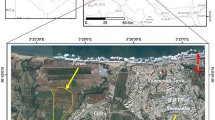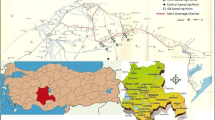Abstract
In this study an assessment is made of the negative impacts of wastewater irrigation on soils and crops sampled along the Khoshk River channel in suburban area of Shiraz City, SW Iran. For this purpose, samples of soil profiles (0–60 cm in depth) and crops were collected from two wastewater irrigated sites and a tube well-irrigated (control) site. Total concentrations of the five heavy metals (Ni, Pb, Cd, Zn and Cr) and their phytoavailable contents were determined. The Pollution Load Indexes (PLIs) and Contamination Factors (CFs) for soils and Hazard quotients (ΣHQ) for some vegetables were also calculated. The results showed the use of untreated wastewater has caused the following changes as compared to control site: (1) a 20–30% increase in organic matter content of soil; (2) increase in pH by 2–3 units; (3) significant concentration increase in Ex-Ca especially in top layers of soil resulting in high CEC; (4) build up of heavy metals (notably Pb and Ni) in topsoil above Maximum Permissible Limits (MPLs) indicating a moderate contamination (PLI > 1, CF > 2.5); (5) contamination of some vegetables (spinach and lettuce) with Cd due to its high phytoavailability in topsoil causing a HQ > 1; (6) excessive accumulation of Ni and Pb in wheat due to continual addition of heavy metals through long-term wastewater application. The study concludes that strict protection measures, stringent guidelines and an integrated system for the treatment and recycling of wastewater are needed to minimize the negative impacts of wastewater irrigation in the study area.
Similar content being viewed by others
References
Alloway, B. J. (1995). Heavy metals in soils. London: Blackie Academic & Professional.
Al-Nakshabandi, G. A., Saqqar, M. M., Shatanawi, M. R., Fayyad, M., & Al-Horani, H. (1997). Some environmental problems associated with the use of treated wastewater for irrigation in Jordan. Agricultural Water Management, 34, 81–94.
Aziz, O., Inam, A., & Samiullah (1999). Utilization of petrochemical industry waste water for agriculture. Water, Air & Soil Pollution, 115, 321–335.
Bahemuke, T. E., & Mubofu, E. B. (1999). Heavy metals in edible green vegetables grown along the sites of the Sinaza and Msimbazi Rivers in Dar es Salaam, Tanzania. Food Chemistry, 66, 63–66.
Blumenthal, U., Peasey, A., Ruiz-Palacios, G., & Mara, D. D.(2000). Guidelines for wastewater reuse in agriculture and aquaculture: recommended revisions based on new research evidence. Task No. 68, Part 1. Retrieved from persistent URL: http://www.lboro.ac.uk/well/resources/well-studies/full-reports-pdf.
Bohn, H. L., McNeal, B. L., & O’Connor, A. G. (1985). Soil chemistry. New York: Wiley-Inter Science Publications.
Butt, M. S., Sharif, K., Bajwa, B. E., & Aziz, A. (2005). Hazardous effects of sewage water on the environment: Focus on heavy metals and chemical composition of soil and vegetables. Management of Environmental Quality, 16, 338–346.
Cabrera, F., Clemente, L., Diaz Barrientos, E., Lopez, R., & Murillo, J. M. (1999). Heavy metal pollution of soils affected by the Guadiamar toxic flood. Science of the Total Environment, 242, 117–129.
Chen, Y., Wang, C., Wang, Z., & Huang, S. (2004). Assessment of the contamination and genotoxicity of soil irrigated with wastewater. Plant and Soil, 261, 189–196.
Chojnacka, K., Chojnacki, A., Górecka, H., & Gorecki, H. (2005). Bioavailability of heavy metals from polluted soils to plants. Science of the Total Environment, 337, 175–182.
Codex Alimentarius Commission (1984). Contaminants. Joint FAO/WHO Food Standards, Codex Alimentarius, Vol. XVII (1st ed.).
Commission Regulation (No. 466/2001) (2001). Setting maximum levels for certain contaminants in foodstuffs. Official Journal of the European Communities, L77, 7–11.
Cui, Y. J., Zhu, Y. G., Zhai, R. H., Chen, D. Y., Huang, Y. Z., Qiu, Y., et al. (2004). Transfer of metals from soil to vegetables in an area near a smelter in Nanning, China. Environmental International, 30, 785–791.
de Matos, A. T., Fontes, M. P. F., da Costa, L. M., & Martinez, M. A. (2001). Mobility of heavy metals as related to soil chemical and mineralogical characteristics of Brazilian soils. Environmental Pollution, 111, 429–435.
Ensink, J. H., van der Hoek, W., Matsuno, Y., Munir, S., & Aslam, M. R. (2002). Use of untreated wastewater in peri-urban agriculture in Pakistan: Risks and Opportunities. Research report 64, Colombo: International Water Management Institute (IWMI).
Feigin, A., Ravina, I., & Shalhevet, J. (1991). Irrigation with treated sewage effluent. Berlin: Springer.
Friedel, J. K., Langer, T., Siebe, C., & Stahr, K. (2000). Effects of long term wastewater irrigation on soil organic matter, soil microbial biomass and its activities in central Mexico. Biology and Fertility of Soils, 31, 414–421.
Hakanson, L. (1980). An ecological risk index for aquatic pollution control: A sedimentological approach. Water Research, 14, 975–1001.
Harter, R. D. (1979). Adsorption of copper and lead by Ap and B2 horizons of several northeastern United States soils. Soil Science Society of America Journal, 43, 679–683.
Horswell, J., Speir, T. W., & van Schaik, A. P. (2003). Bio-indicators to assess impacts of heavy metals in the land-applied sewage sludge. Soil Biology & Biochemistry, 35, 1501–1505.
Hu, C., Zhaug, C. T., Huang, Y. H., Dahab, M. F., & Surampalli, R. (2005). Effects of long-term wastewater application on chemical properties and phosphorous adsorption capacity in soils of a wastewater land treatment system. Environmental Science Technology, 39, 7240–7245.
Hussain, I., Raschid, L., Hanjra, M. A., Marikar, F., & Van der Hoek, W. (2001). A framework for analyzing socioeconomic, health and environmental impacts of wastewater use in agriculture in developing countries. Working Paper 26. Colombo: International Water Management Institute (IWMI).
Jones, K. C. (1991). Contamination trends in soils and crops. Environmental Pollution, 69, 311–326.
Kabata-Pendias, A., & Pendias, H. (1992). Trace elements in soils and plants. London: CRC press.
Kabata-Pendias, A., & Pendias, H. (2001). Trace elements in soil and plants. Boca Raton, FL: CRC Press.
Kachenko, A. G., & Singh, B. (2006). Heavy metals contamination in vegetables grown in urban and metal smelter contaminated sites in Australia. Water, Air, & Soil Pollution, 169, 101–123.
Khouri, N., Kalbermatten, J. M., & Bartone, C. R. (1994). Reuse of wastewater in agriculture: A guide for planners. World Bank, Washington D.C., USA: UNDP-World Bank Water and Sanitation Program.
Iran Department of Environment (Irandoe) (1997). The comprehensive study of polluting sources in Shiraz plain (Internal report), Shiraz, p.210 (in Farsi).
Lee, J. S., Choan, H. T., & Kim, K. W. (2005). Human risk assessment of As, Cd, Cu and Zn in the abandoned metal mine site. Environmental Geochemistry and Health, 28, 185–191.
Liu, H., Probst, A., & Liao, B. (2005a). Metal contamination of soils and crops affected by the Chenzhou lead/zinc mine spill (Hunan, China). Science of the Total Environment, 339, 153–166.
Liu, W. H., Zhao, J. Z., Ouyang, Z. Y., Solderland, L., & Liu, G. H. (2005b). Impacts of sewage irrigation on heavy metal distribution and contamination in Beijing, China. Environmental International, 32, 805–812.
Maddady, M., & Ghasemi, A. (2001). The study of pollution in Shiraz plain. Shiraz: Open University. In Farsi.
Madyiwa, S., Chimbari, M., Nyamangara, J., & Bangaria, C. (2002). Cumulative effects of sewage sludge and effluent mixture application on soil properties of a sandy soil under mixture of star and Kikuyu grasses in Zimbabwe. Physics and Chemistry of the Earth, 24, 747–753.
Misra, S. G., & Dinesh, D. (1991). Soil pollution. New Delhi: Ashing Publishing House.
Qadir, M., Ghafoor, A., & Murtaza, G. (2000). Cadmium concentration in vegetables grown on urban soils irrigated with untreated municipal sewage. Environment, Development and Sustainability, 2, 11–19.
Rattan, R. K., Datta, S. P., Chhonkar, P. K., Suribabu, K., & Singh, A. K. (2005). Long-term impact of irrigation with sewage effluents on heavy metal content in soils, crops and groundwater–a case study. Agriculture, Ecosystem & Environment, 109, 310–322.
Reilly, C. (1991). Metal contamination of food. London: Elsevier Applied Science.
Ross, S. M. (1994). Toxic metals in soil–plant systems. UK: Wiley.
Scott, C., Faruqui, N. I., & Raschid-Sally, L. (2004). Wastewater use in irrigated agriculture: Management challenges in developing countries. In C. A. Scott (Ed.), Wastewater use in irrigated agriculture: Confronting the livelihood and environmental realities. Ottawa, Canada: CAB International, International Water Management Institute, and International Development Research Centre.
Sharma, R. K., Agrawal, M., & Marshall, F. (2007). Heavy metal contamination of soil and vegetables in suburban areas of Varansi, India. Ecotoxicology and Environmental Safety, 66, 258–266.
Sinha, S., Gupta, A. K., Bhatt, K., Pandey, K., Rai, U. N., & Singh, K. P. (2006). Distribution of metals in the edible plants grown at Jajmau, Kanpur (India) receiving treated tannery wastewater: Relation with physico-chemical properties of the soil. Environmental Monitoring and Assessment, 115, 1–22.
Shuval, H. I., Adin, A., Fattal, B., Rawitz, E., & Yekutiel, P. (1986). Wastewater irrigation in developing countries: Health effects and technical solutions (324 pp). Technical Paper No. 51. Washington, DC: The World Bank.
Stuczynski, T., & Maliszewska-Kordybach, B. (2001). Current status of information on heavy metals in European soils–contamination and regulation aspects. Proceedings of the Second European Soil Forum, Napoli, Italy.
Tiller, K. G. (1986). Essential and toxic heavy metals in soils and their ecological relevance. Transactions of the XIII Congress of the International Society of Soil Science, 1, 29–44.
Tomlinson, D. L., Wilson, J. G., Harris, C. R., & Jeffery, D. W. (1980). Problems in the assessment of heavy metal levels in estuaries and formation of a pollution index. Helgoland Marine Research, 33, 566–575.
Turkdogan, M. K., Kilicel, F., Kara, K., & Tuncer, I. (2003). Heavy metals in soils, vegetables and fruits in endemic upper gastrointestetinal cancer region of Turkey. Environmental Toxicology and Pharmacology, 13, 175–179.
Tyler, L. D., & McBride, M. B. (1982). Mobility and extractability of cadmium, copper, nickel, and zinc in organic and mineral soil columns. Soil Science, 134, 198–204.
United Kingdom Regulations (1989). Statutory Instrument 1989 No. 1263 Sludge (Use in Agriculture) Regulation. London: MAFF, HMSO.
Urie, D. H. (1986). The status of wastewater irrigation of forest. In D. W. Cole, C. L. Henry, & W. L. Nutter (Eds.), The forest alternative for treatment and utilization of municipal and industrial wastes. Seattle: University of Washington Press.
U.S. Environmental Protection Agency (USEPA) (2003). Integrated risk information system (IRIS). Cincinnati, OH, USA: Environmental Criteria and Assessment Office, Office of Health and Environmental Assessment, Office of Research and Development. Retrieved from persistent URL: http://www.epa.gov/iris/subst/index.html.
Vallero, D. A. (2004). Environmental contaminants. USA: Elsevier.
van der Hoek, W. (2004). A framework for a global assessment of the extent of wastewater irrigation: The need for a common wastewater typology. In C. A. Scott, N. I. Faruqui, L. Raschid-Sally (Eds.), Wastewater use in irrigated agriculture: Confronting the livelihood and environmental realities. Wallingford, UK: CABI Publishing.
Walkley, A., & Black, I. A. (1934). An examination of Degtjareff method for determining soil organic matter and a proposed modification of the chromic acid titration method. Soil Science, 37, 29–38.
Wang, X. J., & Tao, S. (1998). Spatial structures and relations of heavy metal content in wastewater irrigated agricultural soil of Beijing’s Eastern farming regions. Bulletin of Environmental Contamination and Toxicology, 61, 261–268.
Weber, S., Khan, S., & Hollander, J. (2006). Human risk assessment of organic contaminants in reclaimed wastewater used for irrigation. Desalination, 187, 53–64.
World Health Organization (WHO) (2006). Guidelines for the safe use of wastewater, excreta and greywater: Wastewater use in agriculture (Volume II). Retrieved from persistent URL: http://www.who.int/water_sanitation_health/wastewater/gsuweg2/en/index.html.
Xian, X. (1987). Chemical partitioning of cadmium, zinc, lead and copper in soil near smelter. Environmental Science & Technology, A 22, 527–541.
Author information
Authors and Affiliations
Corresponding author
Rights and permissions
About this article
Cite this article
Qishlaqi, A., Moore, F. & Forghani, G. Impact of untreated wastewater irrigation on soils and crops in Shiraz suburban area, SW Iran. Environ Monit Assess 141, 257–273 (2008). https://doi.org/10.1007/s10661-007-9893-x
Received:
Accepted:
Published:
Issue Date:
DOI: https://doi.org/10.1007/s10661-007-9893-x




